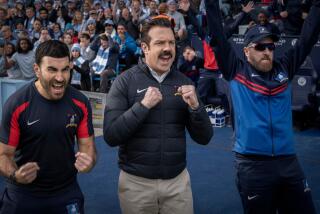Unlocking Television’s Hidden Messages
- Share via
Your television is transmitting hidden messages, but you don’t need to be a crackpot to see them. You just need a remote control.
The messages are closed captions, usually invisible lines of text that correspond to dialogue, music and sounds on the TV screen.
Designed in the 1970s to make TV accessible to millions of viewers who are deaf or hard of hearing, closed captions until a few years ago could be seen only with the help of an expensive decoding machine.
Now, they are commonplace. Since 1993, more than 80 million TVs with closed-caption capability have been sold in the United States. According to some estimates, just about every household in the country will be able to pick up the scrolling texts, which look similar to subtitles, by the turn of the century.
Almost all broadcast network shows are now closed-captioned, as are more and more cable programs. A federal law that took effect Jan. 1 mandates that almost all new programming be captioned by 2006.
As availability increases, so do uses. Captions help children and adults with reading and immigrants with English. At bars, health clubs and airports, the white-on-black text allows viewers to follow TV at a distance or when the din makes it impossible to hear.
Advocates are becoming more vocal about the versatility of captioning, but closed captions remain a mystery to most viewers, moving invisibly--and still encoded--across millions of TV screens.
“Not enough people are aware of them. We’re planning to start a campaign fairly soon called ‘Turn It On,’ ” said Mike Curzan, chief executive officer of the National Captioning Institute in Virginia, a nonprofit agency created by the federal government in 1979 to develop and promote captioning.
Educators value captions as reading and language tools. For example, a teacher in California plays the first half of a TV sitcom with sound and the second half in silence, with his class reading the captions, said Mary Watkins, communications manager at the Caption Center, a 25-year-old nonprofit affiliate of WGBH in Boston and the oldest captioning agency.
Immigrants have made use of closed captions. Before 1993, when captioning was available only via decoding machines, non-English speakers bought more decoders than deaf people did, she said.
Curzan pointed to the frequent display of captions at bars and health clubs. Others use them too.
“We actually have heard from people who use it when they have small babies in the house,” Watkins said. “Or, if you’re sleeping with your spouse or partner and they don’t want to be disturbed, you can turn the captions on.”
Still, captioning is not a feature many TV buyers ask about, according to the Consumer Electronics Industries Assn. And some viewers dislike the way they cover portions of the screen.
Although uses have grown, people who are hearing-impaired, a population of more than 20 million, have been the leading captioning constituency since experimental forms were first displayed in the early 1970s. For them, closed captioning is the difference between being able to watch television and being blocked out.
“Captions provide a critical link to information and news, which are needed to participate in society,” said Karen Peltz Strauss, counsel for telecommunications policy for the National Assn. of the Deaf.
Work on captioning started in the early 1970s. Open captions, those seen by all viewers, were featured in 1971 on “The French Chef” on PBS, a leader in captioning advancements. A 1972 episode of “The Mod Squad” was an early closed-captioning experiment.
Television has taken large strides in recent years, with nearly all network shows and a growing percentage of new cable programming encoded with captions. Movie videos also are captioned. The letters “CC” or a picture of a TV screen with a tail denote captioned programs.
More to Read
The complete guide to home viewing
Get Screen Gab for everything about the TV shows and streaming movies everyone’s talking about.
You may occasionally receive promotional content from the Los Angeles Times.






